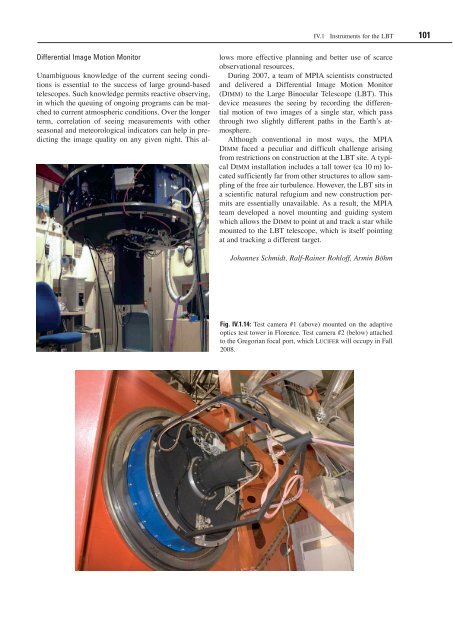Max Planck Institute for Astronomy - Annual Report 2007
Max Planck Institute for Astronomy - Annual Report 2007
Max Planck Institute for Astronomy - Annual Report 2007
You also want an ePaper? Increase the reach of your titles
YUMPU automatically turns print PDFs into web optimized ePapers that Google loves.
Differential Image Motion Monitor<br />
Unambiguous knowledge of the current seeing conditions<br />
is essential to the success of large ground-based<br />
telescopes. Such knowledge permits reactive observing,<br />
in which the queuing of ongoing programs can be matched<br />
to current atmospheric conditions. Over the longer<br />
term, correlation of seeing measurements with other<br />
seasonal and meteorological indicators can help in predicting<br />
the image quality on any given night. This al-<br />
IV.1 Instruments <strong>for</strong> the LBT 101<br />
lows more effective planning and better use of scarce<br />
observational resources.<br />
During <strong>2007</strong>, a team of MPIA scientists constructed<br />
and delivered a Differential Image Motion Monitor<br />
(DiMM) to the Large Binocular Telescope (LBT). This<br />
device measures the seeing by recording the differential<br />
motion of two images of a single star, which pass<br />
through two slightly different paths in the Earth’s atmosphere.<br />
Although conventional in most ways, the MPIA<br />
Di MM faced a peculiar and difficult challenge arising<br />
from restrictions on construction at the LBT site. A typical<br />
Di MM installation includes a tall tower (ca 10 m) located<br />
sufficiently far from other structures to allow sampling<br />
of the free air turbulence. However, the LBT sits in<br />
a scientific natural refugium and new construction permits<br />
are essentially unavailable. As a result, the MPIA<br />
team developed a novel mounting and guiding system<br />
which allows the DiMM to point at and track a star while<br />
mounted to the LBT telescope, which is itself pointing<br />
at and tracking a different target.<br />
Johannes Schmidt, Ralf-Rainer Rohloff, Armin Böhm<br />
Fig. IV.1.14: Test camera #1 (above) mounted on the adaptive<br />
optics test tower in Florence. Test camera #2 (below) attached<br />
to the Gregorian focal port, which Lucifer will occupy in Fall<br />
2008.

















